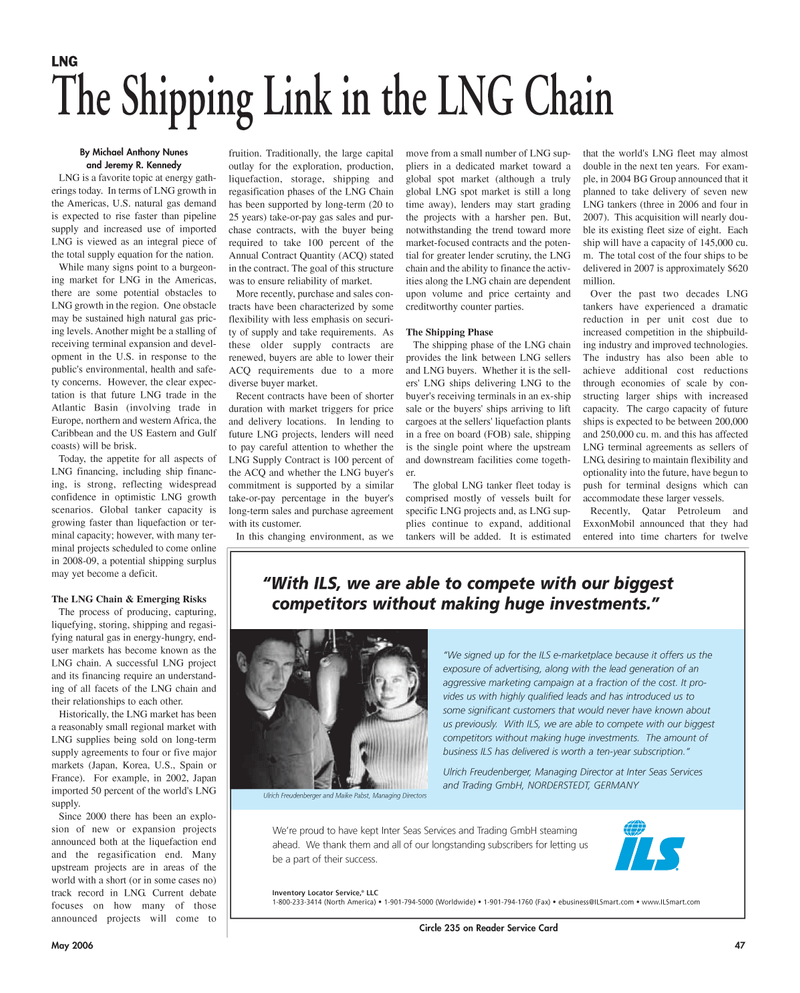
Page 47: of Maritime Reporter Magazine (May 2006)
The Marine Enviroment
Read this page in Pdf, Flash or Html5 edition of May 2006 Maritime Reporter Magazine
May 2006 47
By Michael Anthony Nunes and Jeremy R. Kennedy
LNG is a favorite topic at energy gath- erings today. In terms of LNG growth in the Americas, U.S. natural gas demand is expected to rise faster than pipeline supply and increased use of imported
LNG is viewed as an integral piece of the total supply equation for the nation.
While many signs point to a burgeon- ing market for LNG in the Americas, there are some potential obstacles to
LNG growth in the region. One obstacle may be sustained high natural gas pric- ing levels. Another might be a stalling of receiving terminal expansion and devel- opment in the U.S. in response to the public's environmental, health and safe- ty concerns. However, the clear expec- tation is that future LNG trade in the
Atlantic Basin (involving trade in
Europe, northern and western Africa, the
Caribbean and the US Eastern and Gulf coasts) will be brisk.
Today, the appetite for all aspects of
LNG financing, including ship financ- ing, is strong, reflecting widespread confidence in optimistic LNG growth scenarios. Global tanker capacity is growing faster than liquefaction or ter- minal capacity; however, with many ter- minal projects scheduled to come online in 2008-09, a potential shipping surplus may yet become a deficit.
The LNG Chain & Emerging Risks
The process of producing, capturing, liquefying, storing, shipping and regasi- fying natural gas in energy-hungry, end- user markets has become known as the
LNG chain. A successful LNG project and its financing require an understand- ing of all facets of the LNG chain and their relationships to each other.
Historically, the LNG market has been a reasonably small regional market with
LNG supplies being sold on long-term supply agreements to four or five major markets (Japan, Korea, U.S., Spain or
France). For example, in 2002, Japan imported 50 percent of the world's LNG supply.
Since 2000 there has been an explo- sion of new or expansion projects announced both at the liquefaction end and the regasification end. Many upstream projects are in areas of the world with a short (or in some cases no) track record in LNG. Current debate focuses on how many of those announced projects will come to fruition. Traditionally, the large capital outlay for the exploration, production, liquefaction, storage, shipping and regasification phases of the LNG Chain has been supported by long-term (20 to 25 years) take-or-pay gas sales and pur- chase contracts, with the buyer being required to take 100 percent of the
Annual Contract Quantity (ACQ) stated in the contract. The goal of this structure was to ensure reliability of market.
More recently, purchase and sales con- tracts have been characterized by some flexibility with less emphasis on securi- ty of supply and take requirements. As these older supply contracts are renewed, buyers are able to lower their
ACQ requirements due to a more diverse buyer market.
Recent contracts have been of shorter duration with market triggers for price and delivery locations. In lending to future LNG projects, lenders will need to pay careful attention to whether the
LNG Supply Contract is 100 percent of the ACQ and whether the LNG buyer's commitment is supported by a similar take-or-pay percentage in the buyer's long-term sales and purchase agreement with its customer.
In this changing environment, as we move from a small number of LNG sup- pliers in a dedicated market toward a global spot market (although a truly global LNG spot market is still a long time away), lenders may start grading the projects with a harsher pen. But, notwithstanding the trend toward more market-focused contracts and the poten- tial for greater lender scrutiny, the LNG chain and the ability to finance the activ- ities along the LNG chain are dependent upon volume and price certainty and creditworthy counter parties.
The Shipping Phase
The shipping phase of the LNG chain provides the link between LNG sellers and LNG buyers. Whether it is the sell- ers' LNG ships delivering LNG to the buyer's receiving terminals in an ex-ship sale or the buyers' ships arriving to lift cargoes at the sellers' liquefaction plants in a free on board (FOB) sale, shipping is the single point where the upstream and downstream facilities come togeth- er.
The global LNG tanker fleet today is comprised mostly of vessels built for specific LNG projects and, as LNG sup- plies continue to expand, additional tankers will be added. It is estimated that the world's LNG fleet may almost double in the next ten years. For exam- ple, in 2004 BG Group announced that it planned to take delivery of seven new
LNG tankers (three in 2006 and four in 2007). This acquisition will nearly dou- ble its existing fleet size of eight. Each ship will have a capacity of 145,000 cu. m. The total cost of the four ships to be delivered in 2007 is approximately $620 million.
Over the past two decades LNG tankers have experienced a dramatic reduction in per unit cost due to increased competition in the shipbuild- ing industry and improved technologies.
The industry has also been able to achieve additional cost reductions through economies of scale by con- structing larger ships with increased capacity. The cargo capacity of future ships is expected to be between 200,000 and 250,000 cu. m. and this has affected
LNG terminal agreements as sellers of
LNG, desiring to maintain flexibility and optionality into the future, have begun to push for terminal designs which can accommodate these larger vessels.
Recently, Qatar Petroleum and
ExxonMobil announced that they had entered into time charters for twelve
Inventory Locator Service, ®
LLC 1-800-233-3414 (North America) • 1-901-794-5000 (Worldwide) • 1-901-794-1760 (Fax) • [email protected] • www.ILSmart.com
We’re proud to have kept Inter Seas Services and Trading GmbH steaming ahead. We thank them and all of our longstanding subscribers for letting us be a part of their success. “With ILS, we are able to compete with our biggest competitors without making huge investments.” “We signed up for the ILS e-marketplace because it offers us the exposure of advertising, along with the lead generation of an aggressive marketing campaign at a fraction of the cost. It pro- vides us with highly qualified leads and has introduced us to some significant customers that would never have known about us previously. With ILS, we are able to compete with our biggest competitors without making huge investments. The amount of business ILS has delivered is worth a ten-year subscription.”
Ulrich Freudenberger, Managing Director at Inter Seas Services and Trading GmbH, NORDERSTEDT, GERMANY
Ulrich Freudenberger and Maike Pabst, Managing Directors
Circle 235 on Reader Service Card
LNG
The Shipping Link in the LNG Chain
MR MAY2006 #6 (41-48).qxd 5/8/2006 12:00 PM Page 47

 46
46

 48
48
